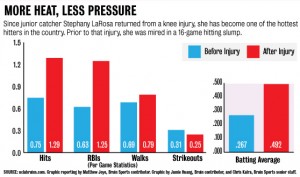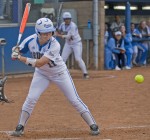
Sometimes, a break from the game can be the best remedy for a slump.
For the first month of the 2014 season, junior catcher Stephany LaRosa was stuck in one of the toughest hitting droughts of her career. But since being injured for two weeks in the beginning of March, she has turned her season around.
Entering a three-game series against Stanford (28-21, 3-15 Pac-12) this weekend, LaRosa leads No. 2 UCLA (44-4, 15-3) in slugging percentage and has emerged as arguably the best hitter on the team.
“She can literally be the scariest hitter in the country, I truly believe that,” said coach Kelly Inouye-Perez.
This scenario of LaRosa being the leader of the UCLA offense was one that many expected to see coming into the 2014 season.
But expectations were what prevented LaRosa from living up to her potential during the early part of the season, before a knee injury gave her some time to recalculate her approach at the plate.
Prior to the season, it looked on paper as if 2014 would be LaRosa’s breakout year.
She was Pac-12 Freshman of the Year in 2012 and made first team All-Pac-12 in each of her first two seasons. LaRosa and then-senior outfielder B.B. Bates were the team’s two leading hitters in 2013.
With Bates’ graduation last spring, LaRosa was eager to step up as the team’s leading run producer.
“When I stepped in the (batter’s) box at the start of this season, I kind of felt like I had to get things done, I had to make things happen,” LaRosa said.
But LaRosa said that she would still have put this additional pressure on herself regardless of whether or not Bates was still on the team. LaRosa felt that she needed to step up as a leader because she was an upperclassman for the first time in her career.
“We haven’t been to the world series in a couple of years and just feeling that urgency (to get things done). … Feeling like I’m kind of like a veteran,” LaRosa said.
On top of living up to her goal of being a team leader, LaRosa had to adapt to a significant position change on defense. Last fall, she made the switch from shortstop to catcher after a trio of concussions forced former catcher Alyssa Tiumalu to switch to a less dangerous position.
Inouye-Perez, who played catcher at UCLA from 1989 to 1993, knew how difficult LaRosa’s position change would be.
“You cannot put (just) anyone back behind the plate,” Inouye-Perez said. “(In)
the beginning of season, there was a lot of anxiety about (her ability to catch).”
Ironically, LaRosa made a smooth transition to the catcher spot but went through more of a struggle on offense. She desperately wanted to step up and produce runs for her team, but she was placing too much pressure on herself.
“I got in the box trying to do too much,” LaRosa said. “I would get tense and muscle up and I wouldn’t get the outcome that I wanted.”
After the first month of the season, LaRosa was batting more than 100 points below her career batting average. Then, a knee injury forced her out of the lineup, giving her a break from the pressure, so she could regroup mentally.
When LaRosa was injured, she noticed her team could win in different ways.
Although the Bruins scored fewer runs per game when LaRosa was out, they got more walks and had more sacrifice hits. Other players also showed that they could step up and provide power in LaRosa’s absence, as UCLA increased its home run per-game average during LaRosa’s absence. Overall, the Bruins went 7-1 without LaRosa, including a win over No. 6 Michigan.
“Once she was out, we more had to rely on just the teamwork aspect and not having to rely on one teammate,” said sophomore catcher Brittany Moeai. “And I think that really helped us as a whole – just kind of producing runs together.”
When LaRosa returned, she settled into this disciplined and patient offensive approach that she saw working for her teammates. She realized that being an offensive leader didn’t mean getting a big hit in every at-bat.
“You know, I’ve now realized that it’s OK to take that walk and, you know, get the person behind me to get an opportunity to get a hit,” LaRosa said.
As LaRosa became more patient at the plate, she started to look more like the standout offensive player that she had been in her first two seasons.
“(LaRosa) just wasn’t Steph LaRosa with her quality at-bats earlier in the season,” Inouye-Perez said. “And she’s settled in to a point where I think her strength is she’s got great discipline.”
Since LaRosa’s return from injury, her offensive numbers have skyrocketed, and the team has excelled. The Bruins are currently riding an 11-game win streak, and LaRosa has 14 RBIs during that span.
But if not for the injury giving her a short break from her hitting slump, LaRosa may have continued to press, instead of thinking of how thankful she was just to be playing.
“It is rough being out and you kind of don’t realize what you have until it’s gone,” LaRosa said. “So when you do get that opportunity to step back on the field, you know it just has a lot more meaning.”
